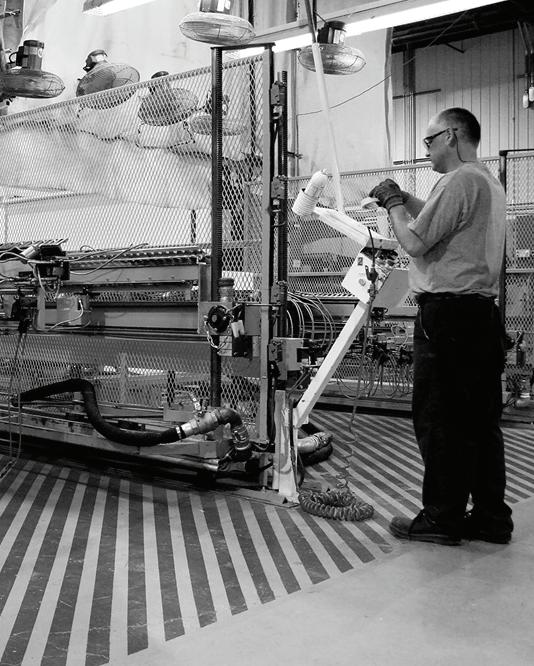
12 minute read
Action Items by Factor Summary
appendIx b
aCtIon Items summarIzed:
Advertisement
On-Boarding
• Making positive first impressions by smiling and asking the new team members how their day is going . • Giving new-hires a tour of the facility and familiarizing them with their surroundings on Day 1 . • Clearly defining and explaining the job, role, expectations, responsibilities, and providing clear and effective training to our new-hires . • Making regular follow-ups throughout the first day and through the first few weeks with your new team members to ensure that they are comfortable and have the tools and resources they need . Regular follow-ups with new team members should occur 3-4 times per day within the first couple of weeks . This will ensure that team members are comfortable, confident, and have what they need to be successful .
• Begin “stickies” with new team members from Day 1 .
Ask new team members a little bit about themselves and get to know them so they feel comfortable and begin making connections with other team members at work . • Compliment new team members often on their progress .
Celebrate the small wins frequently during the first few weeks .
• Take new team members out to lunch .
• Introduce new team members to each person on their team and assign a buddy for the first few weeks . Hold the new-hire buddy accountable for sticking with the new-hire .
• Introduce new team members to each supervisor and leader .
• Hold a team lunch within the first couple of weeks . • Discuss who ABG is as a company to form an emotional bond and show new team members the values and vision of the awesome company we work for (ABG mission, vision, Core Drivers, Origins Story, Leadership
Highlight stories, ABG Core Cultural Values) .
For more suggestions and methods of on-boarding employees and increasing engagement during the on-boarding process, please refer to our Employee Engagement Handbook and our On-Boarding Training Video .
manager faCtors
• Demonstrating true care for your employees • Taking responsibility, as a leader, for engagement • Stickies
• Commitment: Leadership commitment and daily discipline • Coaching and Mentoring • Showing how our company, teams, and team members are winning • Showing teams and team members the fruits of their labor (i .e . how their work makes a difference)
• Practicing open communication with team members • Providing strong support to team members • Motivating and inspiring team members • Giving consistent and clear feedback and direction • Giving recognition to employees both publicly and privately • Forming strong, trusting relationships with your team and team members
• Putting the right employees in the right positions • Empowering employees • Setting clear expectations • Giving the tools, training, and resources to team members that are necessary to do their job • Establishing strong growth and development plans and holding team members accountable for reaching new goals (both behaviorally and tactically) • Creating Pride
employer faCtors
Organizational Level
• Company-wide recognition (i .e . ABG Way Highlight stories – formerly known as I AM CX) • Equal enforcement of rules and policies among all employees at the organizational level • Leadership connection at the organizational level • Leadership highlight boards • Leadership Videos • Common culture connecting us all • Frequent internal communications regarding ABG culture, core drivers, mission, and vision to unite us all under a common purpose and expectation .
Division Level
• Division leaders giving recognition to teams and individuals for their excellent work
• Team leaders giving recognition to teams and individuals for their excellent work
• Equal enforcement of rules and policies among all employees at the division level • Equal enforcement of rules and policies among all employees at the team level • Leadership connection at the division level (i .e . daily walk the floor, stickies, etc .) • Leadership connection at the team level (i .e . stickies, walk the floor, etc .)
• Common culture connecting us all (division leaders and team leaders)
• Frequent discussion about our culture, mission, and vision – bringing us all together under a common purpose and common expectation

empoWerment
• Leaders taking ideas for innovation from their teams seriously • Giving employees the ability to make autonomous decisions
• Asking input from employees before implementing changes (when appropriate) • Using suggestion boxes • Forming innovation groups within your team • Asking for feedback before and after changes • Teaching team members to see waste and
CI opportunities • Asking for regular team input • Creativity – Anything else that you feel would empower your team . Get creative .

expeCtatIons
• Expectations: Clearly defining expectations from your team members through ∙ Job descriptions ∙ Role defining (task inventories and responsibilities) ∙ Performance baselines and continuous measurements ∙ Goal-setting and tracking (KPIs, Hour by Hour boards, etc .) ∙ Performance feedback ∙ Open communication and tough love ∙ Coaching and mentoring ∙ Performance reviews
• Goals: Challenging team members through increasingly difficult goals (i .e . SMART goals) • Assistance: Clearly defining for team members who they should go to for help • Feedback: Giving honest, real feedback . This may mean tough love, which as a leader you will have to get comfortable with .
• Feedback: Taking action to invite and give regular feedback . ∙ Creating open-door policies ∙ Allowing for thoughtful discussion and disagreement in meetings without getting emotional ∙ Asking for feedback on your thought-processes and where you stand as a leader regularly ∙ Being honest with your team members about their performance and showing them how they can improve ∙ Creating a culture where truthfulness and transparency are valued, even if that means showing tough love (i .e . getting negative but truthful feedback) .
tools, traInIng, and resourCes
• Standard Visual Work instructions
• Checking in regularly with new-hires to ensure they have what they need to be successful (3-4 times per day in the first few weeks) • Making comprehensive lists of the tools, training, and resources required for a position and ensuring that each are executed during on-boarding and throughout a team member’s tenure
• Ensuring that each position that you are responsible for leading has strong training programs that are laid out clearly and comprehensively, and that team members are trained on each aspect of the training program • Holding responsible parties accountable for executing their portion of the training program • Tracking training program progress and ensuring that trainees are completing each phase of the program . • Ensuring training program effectiveness and revamping ineffective training programs • Ensuring that your team’s tools are working properly • Asking team member’s feedback on training program effectiveness and gathering input on any resources they may need to be successful • Anything else you can think of that would improve the quality of tools, training, and resources your team members need to be successful
• Revamping training programs and holding parties accountable • Frequent check-ins with new-hires or existing team members who are learning a new skill • Feedback from team members regarding training program effectiveness and other resources they may need • Investing in tools that enhance the job as opposed to hindering performance • Ensuring resources are in place to maximize performance

Job fIt
• Ensuring that candidates fully understand the job and its responsibilities before accepting the position . • Fully discussing ABG and its principles to ensure that the candidate is a fit for the organization . • Ensuring that a job candidate meets the knowledge, skills, abilities, and personality required for the job before hiring them . • Easing new employees into the position over the first couple of weeks so that they can get a feel for the position and ensure that it is a good fit before both parties invests more time and energy . • Speaking with team members regularly about how they are doing in their position . If they strongly dislike the position, find another position that is more suitable if possible . If they are happy with the position but strongly desire to take on more responsibility, give it to them . • If a team member wants to take on more responsibility or learn new skills (e .g . cross-training), help them do so .
groWth and development
• Alignment: As leaders, you must get on the same page as your team members by having frequent conversations with them about what their aspirations are . Some team members simply want to come in to work, complete their hours and go home . Others want to grow and take on increasing responsibilities and learn the skills that comes with it . Get on the same page as them and make a plan to get them to their next level of performance . • Growth and Development Plans: Establish clear baselines of performance for your team members and establish growth and development plans that, if followed, will take your team members to the next level of their performance .
Baseline performance measures should be tied specifically to the tasks and responsibilities of the job, and growth and development should follow the SMART acronym . • Follow-up: Follow up on your team members progress within the growth and development plan regularly to ensure that they are being held accountable . • Future Outlook: Talk to your team members about their future in the company, where you see them going, and what opportunities there are for growth into higher positions . • Cross-training: Cross-training employees is a practice that has been success across ABG . This helps expand our team members skills sets and the value they provide, keeps efficiency up, decrease boredom and complacency on the job, and shows our team members we care for them and that we are willing to invest in them .

team-related faCtors
• Relationship Formation: Ensure that organic opportunities for positive relationship formation frequently present themselves between team members (e .g . assigning buddies for the first couple weeks of on-boarding, consistent follow-up with new-hire by management, new-hire lunches, etc .) . • Rules of Engagement: Set clear expectations with each of your team members regarding how they are to engage with one another – what is acceptable and what is not – as well as discuss the importance of having good relationships with each other . • Positive Reinforcement: Reinforce positive team members behaviors and define what being a good team member is for your team • Drama and Chaos: Manage problems between team members as soon as they start . Have tough conversations and resolve the issue between team members before it gets any bigger . As our drama and chaos video discusses, do not tolerate drama between team members .
• Placement: Place team members with complimentary personalities together – those that naturally get along well . Separate those that do not . • Team Huddles: Hold daily team huddle meetings where you celebrate wins, discuss daily objectives, give team member encouragement, and anything else you feel you should talk about to build relationships or increase performance . • Care: Bring in food for your team from time to time and enjoy the food together as a team . • Celebrate: Celebrate birthdays, anniversaries, wins, and other milestones together as a team . • Stickies: Encourage stickies among your team members . It is not only important that you have conversations with and demonstrate to your team members that you care and have a genuine interest in them . It is also vital that team members do the same with one another . Have conversations with your team about the importance of stickies and encourage stickies in your daily huddles .
Interdepartmental faCtors
• Human Element: Pick up the phone when possible instead of emailing . This puts the human element back into the interaction and reduces the chance of misinterpretation and conflict . • Rules of Engagement: Set clear expectations for team members regarding how they are expected to interact with other departments (i .e . rules of engagement) . • Processes: As the leader of your team, set up definitive processes between yourself and other departments for getting answers and solving problems so that expectations are crystal clear . Hold your team accountable for these expectations and have regular conversations with leaders from other teams regarding how well these processes are working . • Understanding: Seek first to understand, then to be understood . As true as the maxim is, it is always best to assume the best in someone else’s intentions .
• Common Ground: Always seek to get on the same page as members from other departments and expect the same from your team members . • Set the Tone: As your team’s leader, never speak poorly of any other department or any person from another department . You set the tone for the team so if you speak positively of others, your team will follow . • Speak Kindly: Always talk about and treat other teams the way you want your team to be talked about and treated . Do not throw team members from other departments under the bus in email, on the phone, or through any other communications medium to the customer or the anyone else in the company .

Cultural faCtors
• Set the Example: Living our core cultural values (taking care of each other, taking care of the customer, and doing good work) as the leader of your team . You are the example that your team will follow . • Common Purpose: Uniting your team through a common purpose and common expectations aligned with our cultural values, the ABG Way . • Common Connection: Common culture connecting us all (division leaders and team leaders)
∙ Frequent discussion about our culture, mission, and vision – bringing us all together under a common purpose and common expectation . • Generational Gap: Dedication towards effectively work with and leading those belonging to younger generation









